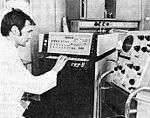CER-203
CER (Serbian: Цифарски Електронски Рачунар – Digital Electronic Computer) model 203 is an early digital computer developed by Mihajlo Pupin Institute (Serbia) in 1971. It was designed to process data of medium-sized businesses:
- In banks, for managing and processing of accounts, bookkeeping, foreign-currency and interest calculations, amortization plans and statistics
- In manufacturing, for production planning and management, market data processing and forecasting, inventory management, financial document management and process modelling
- In utilities, to calculate water and electricity consumption, to produce various reportsand lists and for technical calculations and design
- In construction industry for network planning method design, financial management and bookkeeping
- In trading companies for payment processing, market analysis, inventory management and customer and partner relationship management

CER-203: CPU testing

Block diagram
Specifications
Central Processing:
- Type: BMS-203
- Number of instructions: 32
- Performance:
- one 16-cycle instruction: 20 μs
- one single cycle instruction: 5 μs
- addition and/or subtraction of two 15-digit numbers: 20 μs
Primary memory:
- Capacity: 8 kilowords
- Speed (cycle time): 1 μs
- Complete, autonomous memory error checking
- Parity control
Punched tape reader:
- Dielectric-based reading
- Speed: 500 to 1,000 characters per second
- Accepts 5, 7 and 8-channel tapes
Tape puncher:
- Speed: 75 characters per second
Parallel Line Printer 667:
- "On the fly" printing
- 128 characters per line
- Removable/replaceable printing cylinder
- Speed:
- Automatic paper feeder
- Two line spacing settings
- Programamtic tape for discontinuous paper movement
- Maximum number of carbon copies: 6
Independent Printer M 30:
- 132 characters per line
- Speed:
- Maximum number of carbon copies: 6
Magnetic cassettes 4096:
- Capacity: 600,000 characters
- Variable record length
- Transfer rate: 857 characters per second
- Tape speed: 10 inches per second
Magnetic Tape Drives:
- Data format: 9-track ASCII with inter-record space of 0.6 inches (1.524 cm)
- Data density: 556/800 bits per inch
- Capacity per tape: c. 10,000,000 characters
- Tape speed: 24 inches/s, 150 inches/s fast-forward and rewind
- Transfer rate: 19.2 kHz
- Tape width: 1/2 inch (1.27 cm)
- Tape length: 2400 ft (731.52 m)
- Working ambient temperature range: 5 °C to 40 °C
- Relative humidity: up to 80%
- Integrated circuit control logic
- Separate control panel for each drive
- Read/Write Capabilities:
- Read and Write forward
- Read forward
- Read reverse
gollark: TAR is still fairly inefficient even uncompressed, because of the whole "seek through the entire thing" thing.
gollark: I do think complexity should be avoided if possible.
gollark: Zstandard is quite complex, and you seem okay with that.
gollark: So that's irrelevant.
gollark: Although, *are* you implementing TAR yourself?
See also
- CER Computers
- Mihajlo Pupin Institute
- History of computer hardware in the SFRY
References
- M.Momcilovic, D.Hristovic, P.Vrbavac et al.:"Domaci cifarski el.racunari CER", Zbornik Savetovanja AOP u preduzecima, pp. 38–58, Nova Varos YU, May 22, 1969. (in Serbian);
- Miodrag Momcilovic, Miladin Dabic:"Domaci el. sistem za obradu podataka CER 203", Proc.of the VI yougoslav Symposium on AOP, Zagreb, 1972. (in Serbian).
This article is issued from Wikipedia. The text is licensed under Creative Commons - Attribution - Sharealike. Additional terms may apply for the media files.